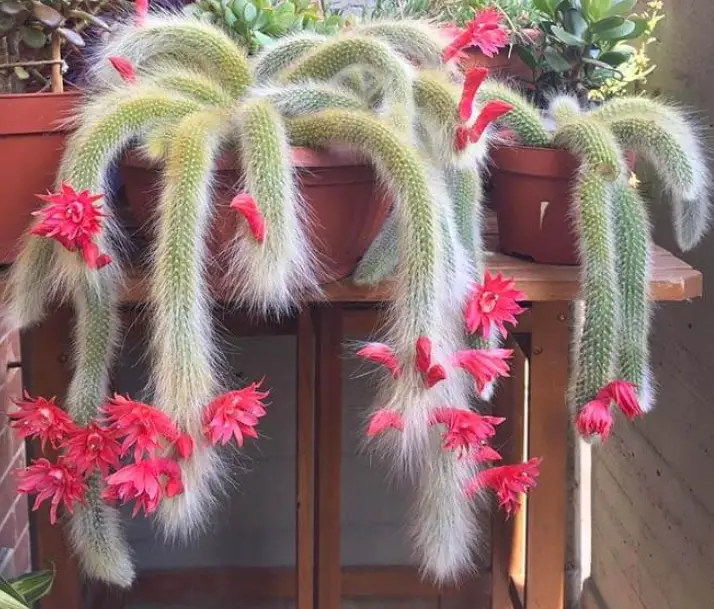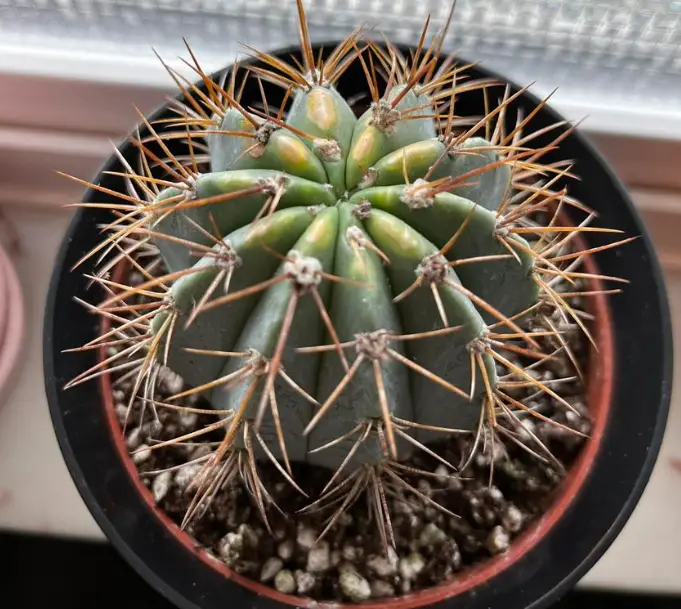The Monkey Tail Cactus: Care and Propagation Guide
Monkey tail cactus, also known as Cleistocactus Colademononis or Hildewintera Colademononis, is a rare species native to the Bolivian countryside in Santa Cruz. It has long stems with white and soft, hairlike spines, which define its name.
This cactus commonly grows on steep rocks and cliffs in the wild with stems hanging downwards. It is a perfect plant for hanging baskets and containers. Their growth starts upright, but the stems droop over as their length increases.

Features and appearance
The monkey tail cactus is often mistaken for the golden rat tail cactus. Still, the main difference is that monkey tail cactus stems grow longer and thicker and appear whitish furrier. They typically look and feel like the tail of a monkey.
This plant blooms in spring or summer, producing large bright red flowers that can be 3 inches long. These decorative flowers last only a few days before they turn into fruits. Monkey tail cactus is classified as toxic, and pets or humans should not ingest any parts.
The monkey tail is a relatively fast-growing cactus, and its stems can grow up to 4 inches per month during spring and summer. Mature plants can reach 2.5 meters in length and 10 centimeters wide. Grow them in sandy, fast-draining soil mix and in bright indirect light.
In summary, here is what to know about the monkey tail cactus:
| Common name | Monkey tail cactus |
| Scientific name | Hildewintera colademononis reclassified as Cleistocactus winteri subsp. colademononis |
| Plant size | 2.5 m tall and about 10 cm wide |
| Soil type | Sandy, fast draining mix |
| Light | Bright indirect light |
| Temperature | 65 to 80 °F during spring and summer and 50 to 55°F during winter. |
| Bloom time | Spring and summer |
| Flower color | Bright red |
| Toxicity | Toxic to humans and pets |
| Hardiness zones | 9a – 11b (USDA) |
| Spil Ph | Between 5.5 and 6.5. |
Monkey tail cactus care and maintenance
Growing and caring for a monkey’s tail cactus is easy, indoors or outdoors. Important things to watch include sunlight, temperature, soil drainage, and grooming.
Light requirements
Monkey tail cactus prefers bright indirect sunlight but can take the morning full direct sunlight. The intense afternoon sun can cause sunburn on the cactus stems. Therefore you need to provide it with shade, especially in very hot climates.
Watering
This monkey tail cacti prefer to stay on the dry side. They are adapted to drought conditions, and overwatering can kill them. During spring and summer, water them when the soil has dry out completely. Cut back on watering when winter arrives and moisten the soil to keep the plant from shriveling.
Soil type
In their natural habitat, monkey tail cacti grow on rocky cliffs. They have a shallow root system and tap most of their water from the air. Therefore, this plant prefers a sandy cactus mix with sharp drainage.
You can grow them in succulent soil mix or make your own cactus soil by amending a regular potting soil with sand or pumice to improve grittiness and drainage. Additionally, use a pot with drainage holes at the bottom.
Temperature
Room temperatures, about 60 – 80°F, are suitable for monkey tail cacti. However, during winter, they prefer cooler temperatures for resting, between 50 and 55°F. They are cold-hardy and can tolerate temperatures as low as -2°F (-19° C).
Fertilization
Monkey tail cacti are good without fertilization. However, you may boost or supplement poor soil in potted plants with a monthly application of balanced fertilizer like 10-10-10 diluted at half strength during growth.
Pruning
Monkey tail cactus won’t need pruning. You may just cut off any dead stems or remove any wilted flowers. I prefer splitting it when it has grown huge instead of trimming it. You can use a sharp knife to cut through the stems and root ball to separate them, then grow them in separate containers.
Repotting
While monkey tail cactus can grow large, you don’t have to repot it often. However, you may have to do it for the purpose of replenishing the soil. Use the right type of soil (cactus soil mix) and a slightly bigger pot with drainage holes at the bottom.
How to propagate the monkey tail cactus
The easiest way to propagate the monkey tail cactus is through rooting of stem cuttings, offsets, or by splitting a mature plant. Seed is also an option, but the success rate is low, especially in a home setup. Propagation is best done in spring when the cactus is growing.
Here is how to propagate Cleistocactus winteri subsp. Colademononis through stem cuttings:
- Use a sharp knife or pruner to take healthy stem cuttings 8 to 12 inches long. Do it away from children and pets, as this plant is toxic.
- Let the cuttings dry out for 5 to seven days. Formation of the callus at the cut end prevents rot and fungal infections.
- Plant the cuttings in fresh cactus soil that is slightly moist. You may dip their bottom end in a rooting hormone to increase the success rate of the propagation.
- Keep the pot or container in a place with bright indirect sunlight and mist the soil whenever it feels dry.
- The cuttings roots in a couple of weeks, 3 to 4. So be patient as to prepare to transplant them or relocate to cactus to your desired place.
If you decide to propagate by rooting the offsets, you must wait until the mother plant produces them. You can then use a sharp knife to separate them from the cactus and grow them in their own pots. Let the pups dry out for several days to form a callus at their ends.
Common pests and diseases
Without proper care, monkey tail cactus can be infested with pest insects such as mealybugs, scale, and spider mites. They can damage the cactus as they suck juices and expose it to fungal and bacterial infections. Overwatering is another problem that can cause root rot.
Houseplant pests can be controlled by using neem oil or insecticidal soap. Use the product as directed for best results. Good care and regular inspection of your plant can help in preventing the problem of pests and diseases. New plants should also be thoroughly inspected.
Final Thought
Moneky tail cacti are highly sought after, probably due to their unique appearance and ease of care. If you add them to your plant collection, grow in sharply draining sandy soil, provide bright indirect light, water it whenever the soil gets dry, and keep the temperature within the recommended range.
References
“Plant care information,” The University of Vermont
“Pruning Cacti And Other Desert Succulents,” University of Nevada extension
“ Houseplant Care,” Oklahoma State University Extension
“Plant biology greenhouse and conservatory,” Southern Illinois University
My name is Diane M Lewik, and I am the founder of this website. I am a degree holder in plant biology from the University of California – Berkeley. Over the years, I have cultivated a vast collection of succulents and I have learned a great deal about how to grow and care for these unique plants. Feel free to ask any questions in the comment section below.





